Landlord Permission Letter
[Your Name]
[Your Address]
[City, State, ZIP Code]
[Email Address]
[Phone Number]
[Date]
[Landlord's Name]
[Landlord's Address]
[City, State, ZIP Code]
Subject: Request for Permission to [Reason for Request]
Dear [Landlord's Name],
I hope this letter finds you well. I am writing to seek your permission regarding a matter that requires your approval as the landlord of the property I am currently renting from you. I have been a tenant at [Property Address] since [Move-in Date], and I have always strived to be a responsible and respectful occupant.
The purpose of this letter is to formally request your permission for the following matter:
[Explain in detail the specific request for which you need the landlord's permission. Be clear, concise, and provide all relevant information. For example, if you plan to sublet the property, make improvements or alterations, bring in a pet, install new fixtures, or any other request that requires the landlord's approval, provide details.]
I understand the significance of adhering to the terms and conditions outlined in the lease agreement, and I assure you that I will comply with any additional requirements or terms you may have for granting this permission. I also understand that any modifications or changes will be my responsibility and will not impose any financial burden on you as the landlord.
I kindly request you to review my application and respond at your earliest convenience. If you require any additional information or documentation to facilitate your decision, please do not hesitate to contact me.
Thank you for considering my request. I value the positive relationship we have had throughout my tenancy, and I am committed to maintaining open communication and transparency throughout this process.
I look forward to your prompt response. Please feel free to contact me via phone or email if you have any questions or need further information.
Thank you for your attention to this matter.
Sincerely,
[Your Name]
[Tenant at [Property Address]]
[Email Address]
[Phone Number]
Permission to Sublet Apartment Letter
Subject: Permission to Sublet Apartment
Dear [Tenant Name],
I, [Landlord Name], hereby grant you permission to sublet the property located at [Property Address] from [Start Date] to [End Date]. This permission is contingent upon the subtenant adhering to all terms of the original lease agreement.
Please ensure that the subtenant is aware of their responsibilities, and notify me immediately of any changes in tenancy.
Sincerely,
[Landlord Name]
[Contact Information]
Permission to Renovate Rental Property Letter
Subject: Authorization for Renovation Work
Dear [Tenant Name],
This letter confirms that you have permission to undertake renovation work at [Property Address]. The renovations are limited to [Specify Work] and must comply with all safety regulations.
All work must be completed by [Completion Date], and any structural changes must be approved in writing before commencement.
Regards,
[Landlord Name]
[Contact Information]
Pet Permission Letter for Rental Property
Subject: Approval for Pet Ownership
Dear [Tenant Name],
I am writing to grant permission for you to keep a [Pet Type] in your rental unit at [Property Address]. Please ensure the pet does not cause damage to the property or disturb neighbors.
This approval is conditional on maintaining cleanliness and adhering to any community pet rules.
Best regards,
[Landlord Name]
[Contact Information]
Permission to Host Event in Rental Property Letter
Subject: Authorization to Host Event
Dear [Tenant Name],
I hereby authorize you to host a private event at [Property Address] on [Event Date] from [Start Time] to [End Time]. Please ensure that the event complies with property rules and local ordinances.
Any damages incurred during the event will be your responsibility.
Sincerely,
[Landlord Name]
[Contact Information]
Temporary Storage Permission Letter
Subject: Permission to Use Storage Space
Dear [Tenant Name],
This letter confirms your permission to use the designated storage area at [Property Address] for a temporary period from [Start Date] to [End Date]. All items must be removed by the end of this period.
Ensure that the storage area remains organized and no hazardous items are stored.
Thank you,
[Landlord Name]
[Contact Information]
What / Why: Purpose of a Landlord Permission Letter
- Provides formal consent from the landlord for specific tenant actions.
- Documents approval for subleasing, renovations, pets, or events.
- Serves as legal evidence to prevent disputes between landlord and tenant.
- Protects both parties by clarifying rights, responsibilities, and limitations.
Who Should Send a Landlord Permission Letter
- The property owner or authorized property manager.
- Individuals responsible for maintaining the lease agreement.
- Any party legally entitled to grant permissions affecting the rental property.
Whom the Landlord Permission Letter Should Be Addressed To
- The tenant requesting permission.
- Subtenants or third parties directly affected by the permission.
- Occasionally, property management offices or insurance providers if required.
When to Send a Landlord Permission Letter
- Before the tenant undertakes any action requiring consent.
- Prior to hosting events, introducing pets, or conducting renovations.
- When legal or lease compliance necessitates written approval.
- To document approvals retroactively if required for disputes or insurance.
How to Write and Send a Landlord Permission Letter
- Clearly state the tenant’s request and the landlord’s consent.
- Include specific details: dates, locations, limitations, and conditions.
- Maintain professional or friendly tone depending on context.
- Sign the letter and provide contact information for verification.
- Deliver via email, postal mail, or hand delivery with acknowledgment.
Requirements and Prerequisites Before Issuing
- Review lease agreement to ensure permission aligns with terms.
- Confirm property rules and local regulations.
- Understand the scope and limitations of the requested action.
- Gather relevant tenant information and property details.
- Determine if additional insurance or security is required.
Formatting Guidelines for Landlord Permission Letters
- Length: usually one page.
- Tone: formal, professional, or friendly based on context.
- Wording: clear, precise, and unambiguous.
- Structure: subject line, greeting, purpose, conditions, signature.
- Mode: printed letter or email depending on urgency and legal requirements.
After Sending / Follow-up Procedures
- Confirm tenant receipt and understanding of permission and conditions.
- Keep a copy for landlord records and lease documentation.
- Monitor compliance with any terms specified in the letter.
- Address any violations or changes in the permission promptly.
Pros and Cons of Issuing a Landlord Permission Letter
Pros:
- Creates formal documentation and legal proof of consent.
- Prevents misunderstandings or disputes between landlord and tenant.
- Provides clarity regarding responsibilities and limitations.
Cons:
- May require additional time for drafting and approval.
- Overly restrictive language can limit tenant flexibility.
- Requires monitoring to ensure compliance.
Common Mistakes to Avoid in Landlord Permission Letters
- Using vague or ambiguous language that does not specify limits.
- Failing to include dates, times, or relevant property details.
- Not signing or delivering the letter formally.
- Overlooking lease agreement restrictions or local laws.
Elements and Structure of a Landlord Permission Letter
- Subject line specifying the type of permission.
- Greeting addressing the tenant or recipient.
- Clear description of the permission granted.
- Specific dates, times, or property areas involved.
- Conditions or limitations attached to the permission.
- Closing statement and signature of landlord or manager.
- Contact information for verification or questions.
Tricks and Tips for Effective Permission Letters
- Keep language concise but detailed enough for legal clarity.
- Include explicit start and end dates for temporary permissions.
- Attach supporting documents if necessary, such as lease excerpts.
- Maintain a professional tone even for informal permissions.
- Retain a copy for records to prevent future disputes.
Does a Landlord Permission Letter Require Attestation or Authorization?
- Usually, the landlord’s signature is sufficient.
- For certain actions like structural changes or subleasing, notarization may be recommended.
- Authorization may be required from property management if they hold legal control over the property.

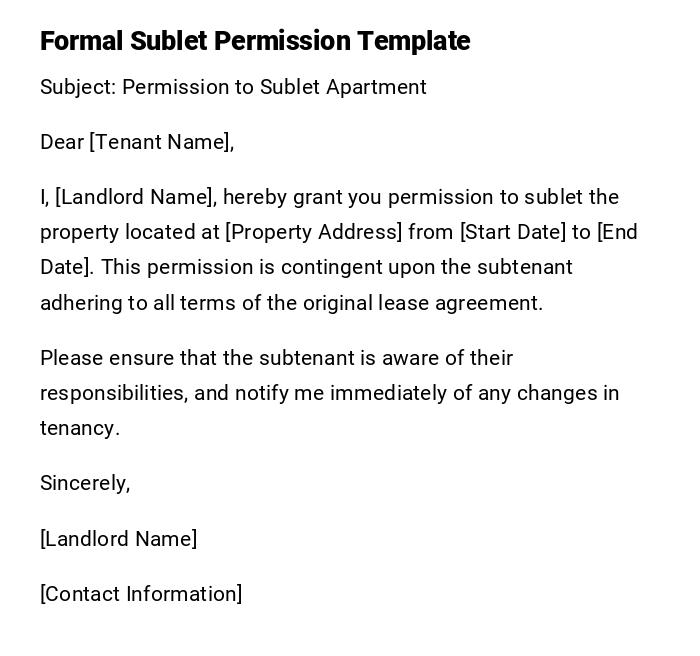
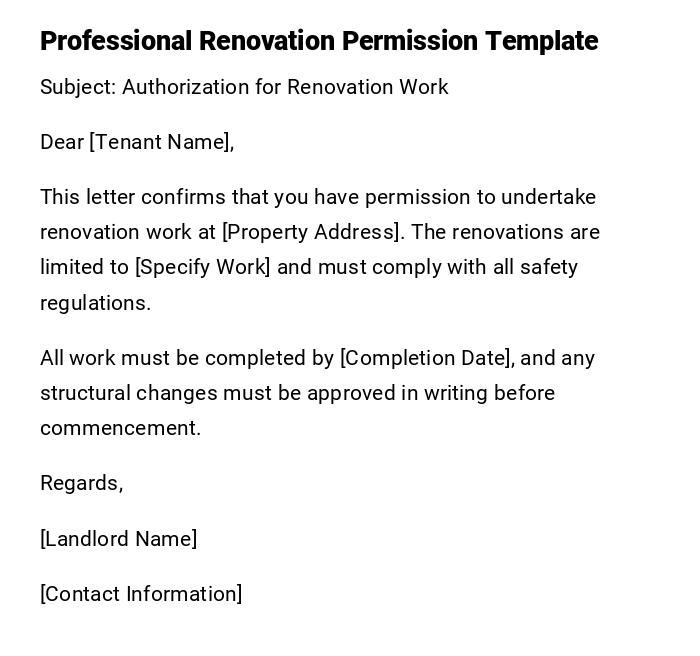
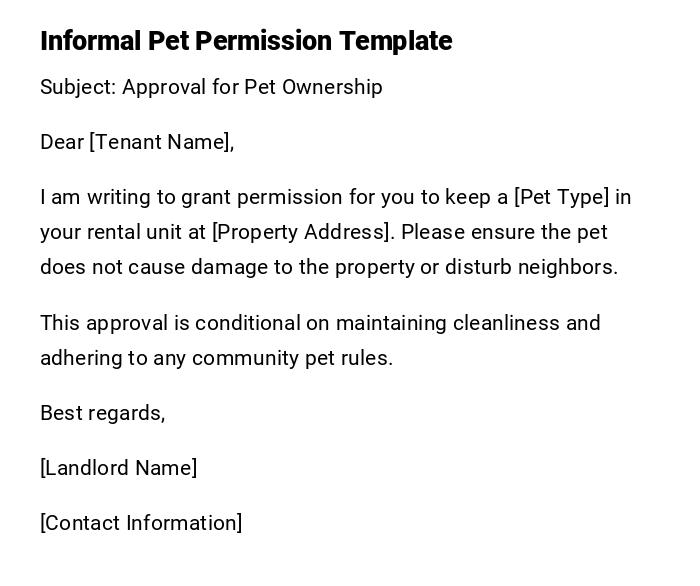
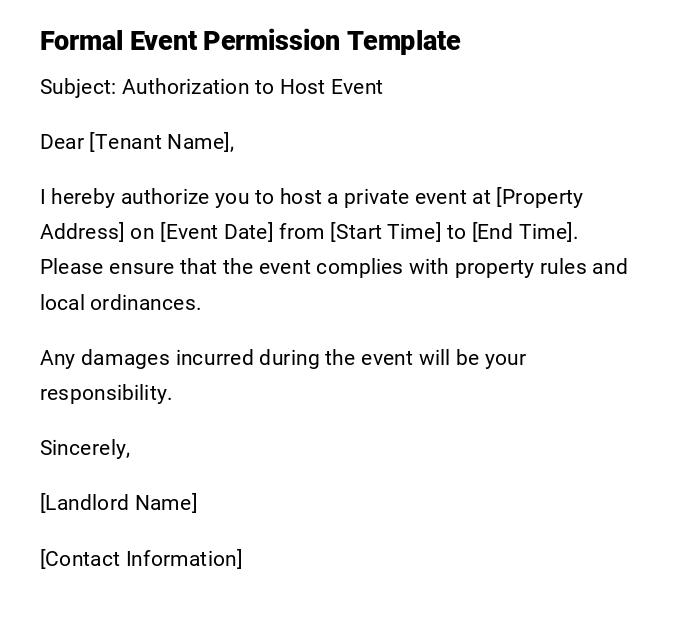
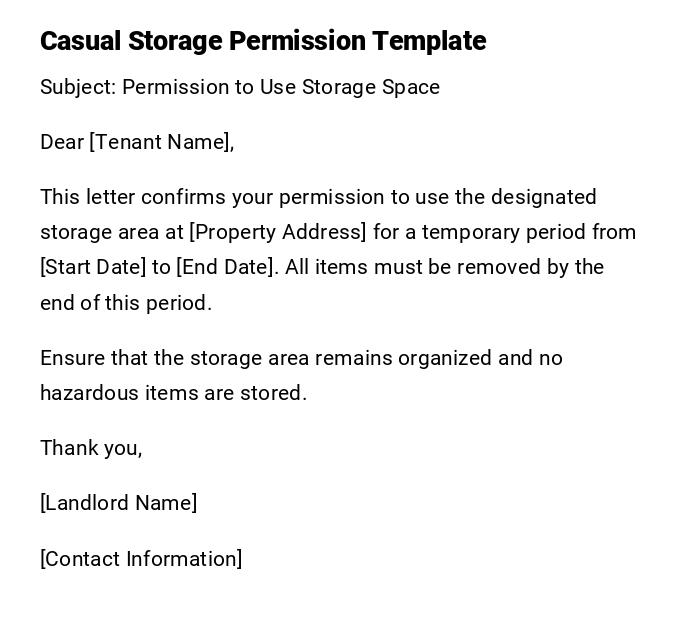

 Download Word Doc
Download Word Doc
 Download PDF
Download PDF